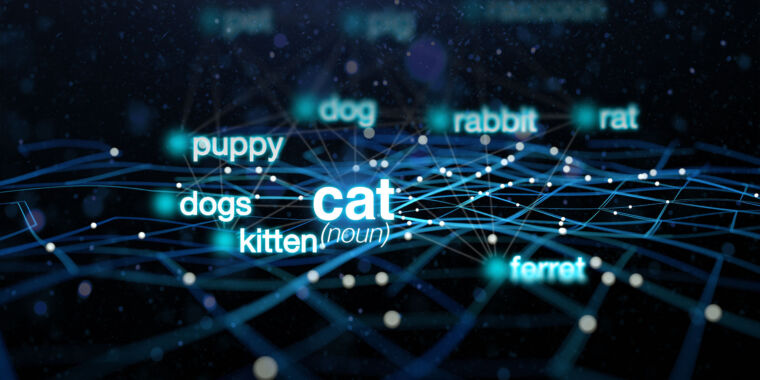Core Concepts
The author aims to demystify the inner workings of large language models, focusing on word vectors and transformers, to make this complex technology accessible to a broader audience.
Abstract
Large language models (LLMs) like ChatGPT have gained widespread attention, but their inner workings remain a mystery to many. These models are built on neural networks trained with vast amounts of text data, making them highly complex and challenging to fully comprehend. The article delves into the representation of words using word vectors and the functioning of transformers in LLMs, shedding light on how these systems operate without delving into technical jargon or advanced mathematics.
A jargon-free explanation of how AI large language models work
Stats
Machine learning researchers had been experimenting with large language models (LLMs) for a few years.
Tens of millions of people have tried out LLMs.
ChatGPT is built on a neural network trained using billions of words.
The full vector representing "cat" is 300 numbers long.
Quotes
"No one on Earth fully understands the inner workings of LLMs."
"The goal is to make knowledge about these systems accessible to a broad audience."
Key Insights Distilled From
by Timothy B. L... at arstechnica.com 07-31-2023
https://arstechnica.com/science/2023/07/a-jargon-free-explanation-of-how-ai-large-language-models-work/
Deeper Inquiries
What implications do AI language models have for future technological advancements?
AI language models, such as large language models (LLMs) like ChatGPT, have significant implications for future technological advancements. These models represent a major leap in natural language processing capabilities, enabling machines to understand and generate human-like text at an unprecedented level. This has the potential to revolutionize various industries and fields.
One key implication is the enhancement of communication between humans and machines. LLMs can facilitate more natural interactions with technology, leading to improved chatbots, virtual assistants, automated customer service systems, and more personalized user experiences across different platforms.
Moreover, AI language models can streamline content creation processes by assisting writers in generating high-quality text quickly. They can also aid in translation services by providing accurate translations between languages.
In addition to these practical applications, LLMs pave the way for further research and development in artificial intelligence. By pushing the boundaries of what machines can achieve in understanding and producing human language, these models open up new possibilities for innovation in areas such as education, healthcare diagnostics through analysis of medical texts or patient records), legal document review automation), sentiment analysis social media monitoring), etc.
Overall, AI language models hold immense promise for driving future technological advancements across multiple sectors by improving efficiency productivity enhancing user experiences advancing research capabilities.
How can the lack of full understanding about LLMs impact their ethical use?
The lack of full understanding about large language models (LLMs) like ChatGPT could significantly impact their ethical use on several fronts. One primary concern is related to biases that may be present within these models due to the vast amounts of data they are trained on without proper oversight or intervention from researchers developers.
If not carefully monitored addressed during training testing phases bias inherent datasets could be perpetuated amplified by LLMs when generating text responses interacting with users). This could lead discriminatory outcomes based on race gender religion other protected characteristics).
Furthermore limitations our knowledge regarding how exactly these systems arrive at decisions predictions makes it challenging to hold them accountable explain their reasoning transparently especially sensitive contexts like healthcare criminal justice where clear justifications are crucial).
Another ethical consideration arises from potential misuse malicious actors who exploit vulnerabilities weaknesses within LLMs manipulate information spread misinformation fake news propaganda). Without comprehensive understanding safeguards place prevent such activities trustworthiness reliability generated content might be compromised leading negative societal consequences).
To ensure responsible ethical use AI language models stakeholders must prioritize ongoing research transparency accountability efforts address mitigate risks associated with limited comprehension complex inner workings).
How might spatial reasoning analogies help in explaining complex concepts beyond AI?
Spatial reasoning analogies serve as powerful tools explaining complex concepts beyond artificial intelligence (AI) by providing relatable visual mental frameworks that aid comprehension retention difficult ideas). Just as we use coordinates vectors describe locations objects physical space similar representations can simplify abstract topics diverse domains ranging mathematics physics computer science psychology others).
By drawing parallels spatial relationships individuals grasp intricate relationships variables entities better visualize connections patterns otherwise elusive intangible). For instance analogy comparing neural networks interconnected nodes brain synapses helps demystify functioning deep learning algorithms general audience familiar biological cognitive processes).
Moreover spatial reasoning analogies foster creativity problem-solving encouraging out-of-the-box thinking novel approaches challenges obstacles faced real-world scenarios). They promote interdisciplinary connections allowing experts different fields collaborate exchange ideas insights leveraging shared conceptual frameworks enhance innovation discovery).
Additionally employing spatial metaphors explanations enhances accessibility inclusivity making technical subjects approachable wider audiences regardless prior knowledge expertise background). Analogies bridge gap unfamiliarity familiarity facilitating learning engagement among learners varying levels experience expertise ensuring information conveyed effectively understood retained over time).
0
